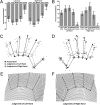An implicit body representation underlying human position sense
- PMID: 20547858
- PMCID: PMC2900654
- DOI: 10.1073/pnas.1003483107
An implicit body representation underlying human position sense
Abstract
Knowing the body's location in external space is a fundamental perceptual task. Perceiving the location of body parts through proprioception requires that information about the angles of each joint (i.e., body posture) be combined with information about the size and shape of the body segments between joints. Although information about body posture is specified by on-line afferent signals, no sensory signals are directly informative about body size and shape. Thus, human position sense must refer to a stored body model of the body's metric properties, such as body part size and shape. The need for such a model has long been recognized; however, the properties of this model have never been systematically investigated. We developed a technique to isolate and measure this body model. Participants judged the location in external space of 10 landmarks on the hand. By analyzing the internal configuration of the locations of these points, we produced implicit maps of the mental representation of hand size and shape. We show that this part of the body model is massively distorted, in a reliable and characteristic fashion, featuring shortened fingers and broadened hands. Intriguingly, these distortions appear to retain several characteristics of primary somatosensory representations, such as the Penfield homunculus.
Conflict of interest statement
The authors declare no conflict of interest.
Figures




Similar articles
-
Posture modulates implicit hand maps.Conscious Cogn. 2015 Nov;36:96-102. doi: 10.1016/j.concog.2015.06.009. Epub 2015 Jun 24. Conscious Cogn. 2015. PMID: 26117153
-
The effects of verbal cueing on implicit hand maps.Acta Psychol (Amst). 2014 Nov;153:60-5. doi: 10.1016/j.actpsy.2014.09.009. Epub 2014 Oct 9. Acta Psychol (Amst). 2014. PMID: 25305592
-
Implicit body representations and tactile spatial remapping.Acta Psychol (Amst). 2015 Sep;160:77-87. doi: 10.1016/j.actpsy.2015.07.002. Epub 2015 Jul 18. Acta Psychol (Amst). 2015. PMID: 26196650
-
Perception, action, and the body model.Neuropsychologia. 2024 Apr 15;196:108853. doi: 10.1016/j.neuropsychologia.2024.108853. Epub 2024 Mar 13. Neuropsychologia. 2024. PMID: 38490535 Review.
-
Touch and the body.Neurosci Biobehav Rev. 2010 Feb;34(2):224-36. doi: 10.1016/j.neubiorev.2009.04.004. Epub 2009 Apr 17. Neurosci Biobehav Rev. 2010. PMID: 19376156 Review.
Cited by
-
Agonist-antagonist myoneural interface surgery on the proprioceptive reconstruction of rat hind limb.Heliyon. 2024 Sep 18;10(18):e38041. doi: 10.1016/j.heliyon.2024.e38041. eCollection 2024 Sep 30. Heliyon. 2024. PMID: 39381245 Free PMC article.
-
A gravitational contribution to perceived body weight.Sci Rep. 2019 Aug 7;9(1):11448. doi: 10.1038/s41598-019-47663-x. Sci Rep. 2019. PMID: 31391471 Free PMC article.
-
Bodily self-recognition and body size overestimation in restrictive anorexia nervosa: implicit and explicit mechanisms.Front Psychol. 2023 Jul 14;14:1197319. doi: 10.3389/fpsyg.2023.1197319. eCollection 2023. Front Psychol. 2023. PMID: 37519354 Free PMC article.
-
Augmented manipulation ability in humans with six-fingered hands.Nat Commun. 2019 Jun 3;10(1):2401. doi: 10.1038/s41467-019-10306-w. Nat Commun. 2019. PMID: 31160580 Free PMC article.
-
Evidence for distorted mental representation of the hand in osteoarthritis.Rheumatology (Oxford). 2015 Apr;54(4):678-82. doi: 10.1093/rheumatology/keu367. Epub 2014 Sep 22. Rheumatology (Oxford). 2015. PMID: 25246638 Free PMC article.
References
-
- Sherrington CS. The Integrative Action of the Nervous System. Cambridge: Cambridge University Press; 1906.
-
- Burgess PR, Wei JY, Clark FJ, Simon J. Signaling of kinesthetic information by peripheral sensory receptors. Annu Rev Neurosci. 1982;5:171–187. - PubMed
-
- Head H, Holmes G. Sensory disturbances from cerebral lesions. Brain. 1911;34:102–254.
-
- Gurfinkel VS, Levick YS. In: Brain and Space. Paillard J, editor. Oxford: Oxford Univ Press; 1991. pp. 147–162.
-
- Soechting JF. Does position sense at the elbow reflect a sense of elbow joint angle or one of limb orientation? Brain Res. 1982;248:392–395. - PubMed
Publication types
MeSH terms
Grants and funding
LinkOut - more resources
Full Text Sources
Medical

